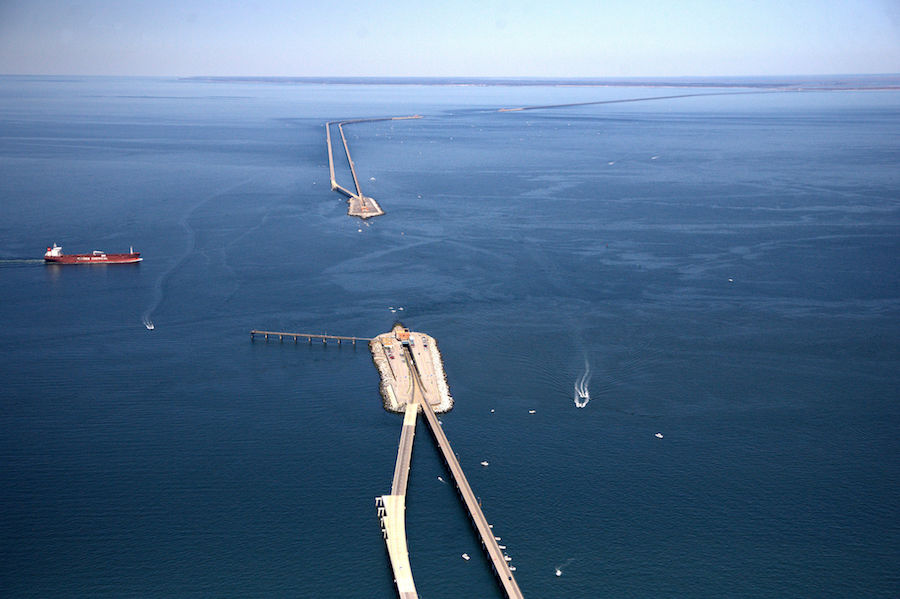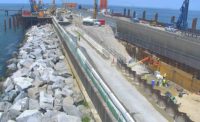A joint venture of Dragados USA Inc. and Schiavone Construction Co. LLC has won a nearly $800-million design-build job for an underwater expansion to Virginia’s 50-year-old Chesapeake Bay Bridge-Tunnel. Construction of the 5,700-ft-long parallel tunnel is slated to begin next fall, at the Thimble Shoals Channel.
On July 28, the joint venture was awarded the $756 million contract by the Chesapeake Bay Bridge and Tunnel District (CBBTD). The selection followed a project re-scoping implemented this past May, after the three short-listed teams’ bids were several hundred thousand dollars above the original estimate.
Mike Crist, district deputy director of infrastructure, says the most significant cost reduction involved eliminating the need to expand the existing 5.25-acre portal islands to accommodate the new tunnel, which will be built using a tunnel-boring machine.
“We also made some changes to trestle-section alignments, to reduce rock-and-fill requirements, and provided clarification on areas that helped the teams refine their estimates,” Crist adds.
Other teams that vied for the project included Archer Western-Vinci Construction Tunnelbuilders and Bouygues TP-Traylor-Manson.
CBBTD, a tax-exempt political subdivision of the Commonwealth of Virginia that operates as a business entity, began developing the Thimble Shoals parallel-tunnel project in 2013 to provide greater safety and reliability along the 20-mile toll-bridge-and-tunnel complex, which carries more than 10,000 vehicles daily across the mouth of the Chesapeake Bay. Tunnels at the Thimble Shoals and Chesapeake channels provide passage for large commercial and military vessels, while high-level bridges span two other navigation channels closer to Virginia’s Eastern Shore.
While a $250-million addition of parallel bridges, completed in 1995, doubled the number of surface lanes, traffic is still channeled into the original two-lane tunnels, which have limited vertical and horizontal clearances. As a result, the tunnels frequently are closed to allow the passage of vehicles with oversize loads.
According to the CBBTD, the Thimble Shoals channel, located approximately 3.5 miles offshore from Virginia Beach, was chosen for a parallel tunnel because of its length, plus the potential for construction and operational risks due to greater maritime volumes. After exploring a variety of project delivery options, including a public-private partnership, the CBBTD elected to use a financing strategy that will combine its financial contribution and toll revenue bonds with a pending TIFIA loan, plus a $50-million loan from the Virginia Transportation Infrastructure Bank.
The choice of construction method was left up to the bidding teams.
“Our objective was to build a new tunnel with a 100-year design life in the most efficient manner,” says Jeff Holland, executive director at CBBTD. “Rather than applying our limited expertise to dictate the construction approach, we set goals and performance specifications for both immersion and bored tunnels and let the industry decide the best delivery tool.”
An advantage of using a TBM, Crist adds, is that it allows the new portals to be built within 50 ft of those constructed for the original tunnel. With an outer diameter of 42 ft, the new tunnel will bend outward by 200 ft as it descends to its deepest point, where the crown will be 105 below the bay's surface.
CBBTD anticipates that approximately 500,000 cu yd of soil will be removed by the TBM, while the tunnel will consist of approximately 9,000 individual sections, totaling 42,000 cu yd of concrete.
“The contractor has a good support-of-excavation package—slurry walls, sheet-pile walls and jet grouting to ensure minimal or no impact to the original structure,” Crist says. “There are also strict guidelines for settlement, which will be closely monitored during construction.” CBBTD selected HNTB as the project’s construction manager in November 2015.
Design and permitting are expected to be complete in early 2017, with construction expected to take approximately five years once a notice to proceed is issued. As such, Crist says the contract’s liquidated damages are “minimal,” structured mainly to cover any administrative and oversight costs CBBTD may incur should delays arise. There is also no early completion incentive.
“Unlike other toll projects, we don’t expect a substantial amount of added revenue from the project, so there’s no urgency to have the new tunnel open by a certain date,” Holland explains.
A $116-million contingency has been set aside for the project; in addition to the design-build contract, CBBTD expects to spend approximately $54 million for management, quality assurance and financing.
While constructing a parallel tunnel for the second, 5,423-ft-long Chesapeake Channel Tunnel remains part of CBBTD’s long-term plans, no action is anticipated prior to 2040.




Post a comment to this article
Report Abusive Comment